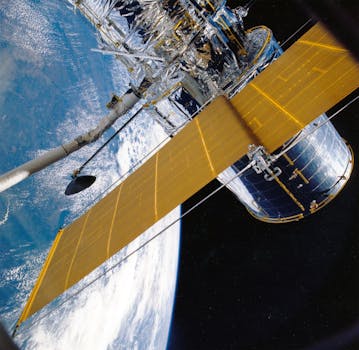GEO Satellites: Unlocking the Power of Geostationary Orbit

GEO Satellites: Unlocking the Power of Geostationary Orbit
GEO satellites, or geostationary satellites, are a type of satellite that orbits the Earth at an altitude of approximately 36,000 kilometers, remaining stationary relative to a fixed point on the planet. This unique characteristic allows GEO satellites to provide continuous coverage of a specific region, making them an essential component of modern satellite communications. In this article, we will delve into the world of GEO satellites, exploring their benefits, applications, and the impact they have on the telecommunications industry.
How GEO Satellites Work
GEO satellites operate by transmitting and receiving signals to and from Earth-based stations. They are typically equipped with transponders, which are devices that receive a signal, amplify it, and then re-transmit it back to Earth. The signals transmitted by GEO satellites can be used for a variety of purposes, including television broadcasting, telecommunications, and weather forecasting. One of the primary advantages of GEO satellites is their ability to provide continuous coverage of a specific region, making them ideal for applications that require a high level of availability and reliability.
Applications of GEO Satellites
GEO satellites have a wide range of applications, including television broadcasting, telecommunications, weather forecasting, and navigation. They are also used for military communications, disaster recovery, and remote sensing. The use of GEO satellites has become increasingly important in recent years, as the demand for satellite-based services continues to grow. With the advent of new technologies such as high-throughput satellites and satellite constellations, the capabilities of GEO satellites are expanding, enabling them to support a broader range of applications and services.
Benefits of GEO Satellites
The benefits of GEO satellites are numerous, and they have revolutionized the way we communicate and access information. Some of the key benefits of GEO satellites include their ability to provide global coverage, high-speed data transfer, and reliable connectivity. They also offer a cost-effective solution for remote or underserved areas, where traditional telecommunications infrastructure may not be available. Additionally, GEO satellites play a critical role in disaster recovery and emergency response, providing vital communications services during times of crisis.
Future of GEO Satellites
The future of GEO satellites is exciting and rapidly evolving. With the development of new technologies such as advanced propulsion systems and electric propulsion, GEO satellites are becoming more efficient and cost-effective. The use of artificial intelligence and machine learning is also being explored, enabling GEO satellites to operate more autonomously and efficiently. As the demand for satellite-based services continues to grow, the importance of GEO satellites will only continue to increase, driving innovation and advancement in the field of satellite communications.



